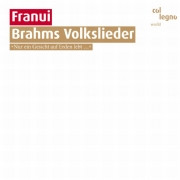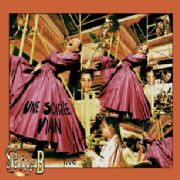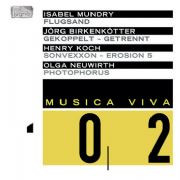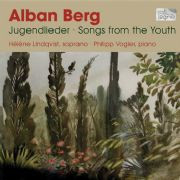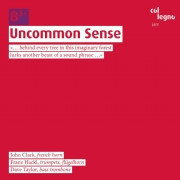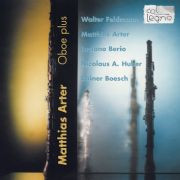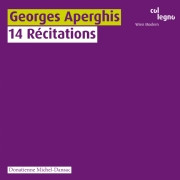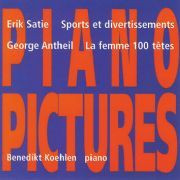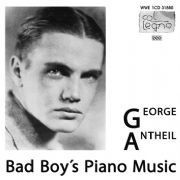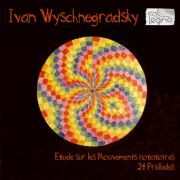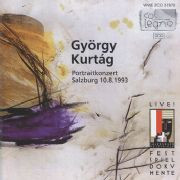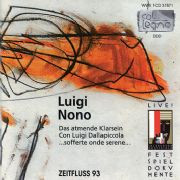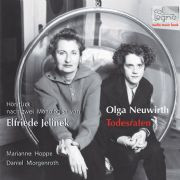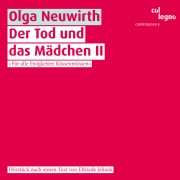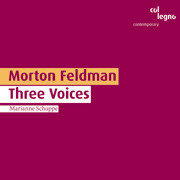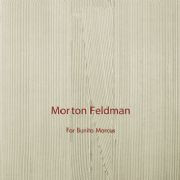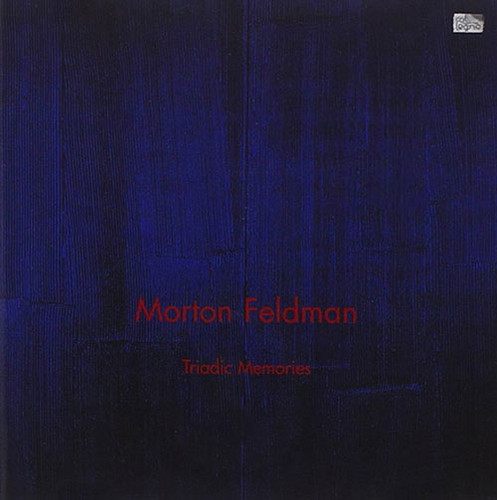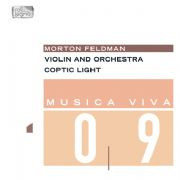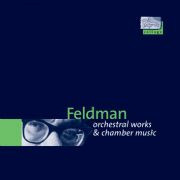Brahms’ Deutsche Volkslieder
"Only one face": Following their price-winnig recording Schubertlieder, the Tyrolean Musicbanda Franui have now taken up Johannes Brahms' German Folk Songs.
Une Soirée Vian
The Soirée Vian, a kind of meta-cabaret created in 1991 based on a commission by the WDR, develops along the narrative red thread of Boris Vian's novel The red grass and turns into a dizzying journey through the absurdly crazy worlds of Vian's universe. The fullness and polystylism of this venture undertaken by Denys Bouliane might indeed almost make the listener dizzy, not least due to the fantastic performance by the electro-acoustic ensemble "Série B." Their "musical roller coaster ride from …
Musica Viva 02
Musica Viva 02: Space and sound, modernism and pluralism, "perfect harmony" and, finally, the fascination of collectively organized fireflies.
Jugendlieder - Songs From The Youth
Berg's early lieder owe their existence largely to the young composer's great interest in literature; nevertheless it was his friend Hermann Watznauer, who actually inspired him to embark on composing his first lieder around 1900/01. And Berg enjoyed himself so much that he continued along the same lines until 1903, completing another 30 lieder; even Arnold Schönberg was essentially fascinated by them: "Berg's earliest compositions, however clumsy they may have been, already reveal two qualities…
Uncommon Sense
This is: brass to the power of three, and a lot more besides. John Clark, Dave Taylor and Franz Hackl on French horn, trumpet and bass trombone are not just a brass trio but create a whole cosmos of sounds, styles and techniques. In their musical actions and reactions, each of the three is always also each of the other two, with the voices merging into complex moods and styles. On this album the trio reveal their sense of humor, and a moment later become absorbed in hymnic devotion. Big-band ges…
Eisenhans!
Following the great success of Mitterer's "Brave little tailor" our second children's opera is now available on CD: Eisenhans! Child-friendly and light-hearted.
Oboe plus
Right at the start we are welcomed by Le sexe du noyé by Walter Feldmann, which (besides requiring exceptional technical skill) keeps a tight rein on the oboist, even as far as inhaling and minute movements are concerned. But Matthias Arter does not play the oboe only but also other members of the customary concert instrument's family, like the musette (sopranino oboe) he uses in the last part of his own composition Changes. And he has a lot more to offer even than a great variety of different p…
14 Récitations
A songbird that stops singing must die. Georges Aperghis demands a similar degree of self-sacrifice of the performer of his 14 Récitation.
Piano Pictures
Now, which are the points of contact between these two composing gentlemen? "In both composers, a childlike quality shows in their indifference (or impartiality) towards the utilizable musical material: 'sophisticated' and 'lesser' styles, ragtime and music hall, neo-gothic and bitonality, typing machine and doorbell, jocular or praising quotes – everything is linked with everything, without any previous weighing and selection, without preconditions, following a kind of anarchic play instinct. […
Bad Boy\'s Piano Music
George Antheil was not only always ahead of his time; he was also an alert contemporary and ready to take in all artistic trends of the first half of the 20th century. There was hardly a kind of music he wasn't aware of, hardly a madness he didn't take part in, and hardly a scandal he missed, or missed to cause. All his personal entanglements are certainly reflected in his compositions – and we wouldn't expect any less from him; but his continuing reputation as a genuinely unique character is ne…
Étude sur les Mouvements rotatoires / 24 Préludes
The master of partial tones: Ivan Wyschnegradsky continued Scriabin's harmonic principles and (successfully) searched for new tone colors.
Portraitkonzert Salzburg 10.8.93
Recorded in Salzburg on August 10, 1993, this recording documents a portrait concert devoted to the music of György Kurtág that spans most of his career, from his Op. 1, first string quartet, written when he was in his forties, to works of recent years. The performers are a star-studded gallery of mostly-Hungarian musicians, many closely associated with Kurtág's music, including the pianist Zoltan Kocsis, the soprano Adrienne Csengery, the Keller Quartet, the cellist Miklos Perenyi and the compo…
Das atmende Klarsein
Researching into the fringe ranges of hearing, and actually going to the limits: electronics – live or prerecorded – was one of the tools employed by Luigi Nono in pursuance of this object. In his work Das atmende Klarsein he moreover endeavored to expand the ability of listening: "Waking up the ear, the eyes, human understanding, intelligence, is what is essential today," the composer, also a politically aware man, observed in the early 1980s. Das atmende Klarsein "is a key work of Nono's final…
Todesraten
The black widow and the farmer’s son thrown off track by an addiction to steroids often hold forth on their views, insights and the absurdities of life. Every now and then, however, the simul-taneous utterance of text and the very complexity of their relationship create the impression of their having a real conver-sation. The texts are taken from Elfriede Jelinek’s Sportstück, who takes a cynical look at two “favorite sports” of the apparent interlocutors: The woman tells about nursing retirees …
Der Tod und das Mädchen II
The tale of the Sleeping Beauty set somewhere between science fiction and biting social criticism. In her texts Elfriede Jelinek explores the states of sleep, of apparent death, of semi-consciousness, or of being barely awake – and in doing so investigates Austrian everyday life in all its uniqueness, including all the petty power games and battles of the sexes. Jelinek's grim texts, recited by Anne Bennent, Hanna Schygulla and an artificially generated voice, are combined with Olga Neuwirth's t…
Three Voices
This piece is sung by the Swiss “deep voice”, Marianne Schuppe in trio with herself, a feat made possible by playing back recordings of her own voice. This is not minimal music; melodic lines arise, sensual, beautiful, and undoctored, swaying like a lullaby, yet boosting the overall rhythmic intensity. There cannot be many works which demand of the soloist such careful timing, intense concentration and voice control.
For Bunita Marcus
For Bunita Marcus was written in 1985. "This work, which I have dedicated to Bunita Marcus, [...] deals with the death of my mother, and with the notion of a slow death. I simply didn't want the piece to die. So I used this unwillingness compositionally in order to keep the piece alive, like a patient suffering from an terminal disease, for as long as possible." (Feldman) It is not the loud raging, the last furious revolt of a dying human being that Feldman depicts here, but a slow nodding off a…
Triadic Memories
In other works, such as For Philip Guston, which continues for several hours, Morton Feldman actually would go beyond the bounds of possibility, also overtaxing the concentration of both his musicians and his audience. Nevertheless, like these other words Triadic Memories also requires contemplation, listening without restlessness. Though perhaps not intended by Feldman, a strong contemplative element is inherent particularly in this composition, settling like a haze on the tones that seep in sl…
Violin and Orchestra / Coptic Light
Morton Feldman dedicated a whole series of compositions to the relationship between solo instruments and the orchestra: after Cello and Orchestra (1972), Piano and Orchestra (1975), Oboe and Orchestra (1976) and Flute and Orchestra (1977/78) his Violin and Orchestra (1979) marks the conclusion of these "relationship works." The variety of sound accumulated around the violin, or through the violin, in less than an hour's time ranges from delicate whispers to cantilenas in rich tones and sharp rep…
Orchestral Works & Chamber Music
In the early 1970s Feldman increasingly turned his attention to works for orchestra, in most cases combined with a solo instrument, like Piano and Orchestra (1975). One aspect that was important to him in all of these works was a research into sound, an "unceasing effort to create, by way of exclusion and integration, by operating with colored projection surfaces and various spatial levels, a kind of self-supporting structure elastic enough to take up the exactly fixed initial impulse and contin…
